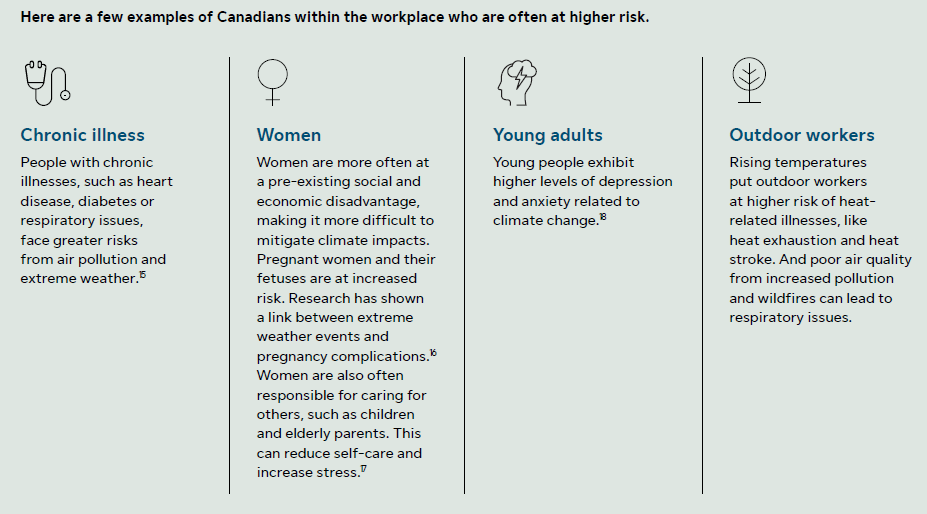Three-quarters of Canadian employees have experienced an extreme weather event in the past three years, and the health impacts are already affecting workplace productivity, according to new research from Sun Life.
The survey of 2,000 full-time Canadian employees found 59 per cent said climate change or severe weather had affected their physical health in the past three years, while 54 per cent reported mental health impacts, said Marie-Chantal Côté, senior vice-president, Sun Life Health.
“One of the most significant impacts of climate change and extreme weather events is on human health,” Côté said in an interview with HR News Canada. The research, conducted in December 2024 with Environics Research, also gathered data 500 employers.
Mental health claims rising
Mental health issues now account for almost 40 per cent of long-term disability (LTD) claims, Côté said. Among employees who reported climate-related health impacts, more than half said it affected their work through reduced productivity, increased absenteeism and lower engagement.
“We’ve seen that number grow year over year for the last five years,” she said. “One can hypothesize that the impact from climate situations is one of the drivers.”
The most common physical health impacts reported were:
- Fatigue or exhaustion (26%)
- Headaches or migraines or increased frequency/severity of headaches or migraines (25%)
- Allergies or increased frequency/severity of allergies (23%)
- Eye irritation e.g., from smoke or poor air quality (21%)
Mental health impacts included:
- Anxiety or worry (29%)
- Stress (27%)
- Difficulty sleeping (24%)
Women and younger workers hit harder
The research found significant demographic differences in who is affected. Women were more likely than men to report climate-related health impacts. Among those with chronic conditions, 45 per cent of women said their condition became harder to manage or more severe, compared to 30 per cent of men.
Younger employees also reported higher rates of impact. Almost half of Gen Z employees — 47 per cent — reported experiencing climate anxiety, compared to 27 per cent of all respondents.
“Climate anxiety is fundamental distress about climate change and its impacts on the landscape and human existence that can manifest as intrusive thoughts or feelings of distress about future disasters or the long-term future of human existence and the world,” according to the survey description provided to employees.
Côté said there are two hypotheses for why women report higher impacts. First, women still tend to be responsible for more caregiving duties, which become more complicated during climate events when daycares close or elderly parents need help. Second, there are historical inequalities in how the health system studies and treats women’s health.
“Women tend to do more of that, or be expected to do more,” she said. “We believe that there’s still some differences in how health is being assessed and analyzed and studied for men and women.”

Chronic conditions worsening
Employees with chronic health conditions were twice as likely to report physical and mental climate-related health impacts. The conditions most affected included migraines, respiratory conditions and allergies, though employees with diabetes and cardiovascular conditions also reported impacts.
“There’s a bit of the double-sided effect there, one from in terms of the conditions, and secondly, in terms of the impact to one’s mental health,” Côté said.
The report notes that 58 per cent of Canadian employees with group benefits plans have one or more chronic health conditions, citing the 2024 Benefits Canada Healthcare Survey.
Regional differences
The degree of health impacts varied by province. Employees in Western Canada and the Prairie provinces were more likely to report impacts, while Quebec employees were least likely.
Alberta employees were 40 per cent more likely than Quebec employees to say they had experienced a recent extreme weather event. Wildfires, air quality issues and heat waves were cited more frequently by those in Western Canada.
Despite unequal experiences of climate events, similar proportions of employees in all provinces reported climate anxiety, with Alberta, the Prairie provinces and Ontario reporting slightly higher levels.
Employer awareness gap
While a majority of employees reported health impacts, only about half of employers said climate-related physical and mental health impacts had affected their workplace. About 50 per cent of employers said they either did not believe their workforce’s health had been impacted or were unaware of any impacts.
The gap was especially large for smaller employers. Just 37 per cent of small employers said employee physical health had been impacted, compared to 64 per cent of employees in British Columbia who reported physical health impacts.
Only about 25 per cent of Canadian employers have plans or strategies to address either the short-term or longer-term impacts of extreme weather events on employee health, according to the survey.
Benefits plans can help
About three-quarters of employers agreed their group benefits plans could provide effective support for climate-related health challenges. However, less than half of employees — 46 per cent — agreed their benefits plan could support them with these challenges.
“It’s good to have these discussions in an organization, first of all, to talk about the impact that some of these environmental challenges have on employees,” Côté said. She recommends organizations discuss both the logistics of extreme weather events and the physical and mental health impacts.
Sun Life offers several programs that can help during climate events, including virtual care through Lumino Health, employee assistance programs, online pharmacy services and chronic disease care programs for conditions like diabetes and respiratory issues.
“Virtual solutions can be used anywhere, anytime,” Côté said. “When you really need it at 9 p.m. in the evening, you can use all those solutions.”
The company has also partnered with the Canadian Lung Association to expand and enhance a free virtual pulmonary rehabilitation program that includes digital modules on managing respiratory symptoms during climate-related events like wildfire season.
Building resilience
Côté emphasized the importance of organizational resilience — the ability of people in an organization to collectively bounce back from challenges.
“We encourage organizations to always have a very strong purpose, because then it helps people connect to that and connect what they do to that purpose, and does drive more meaning and drive more resilience,” she said.
She acknowledged that some employers might question why they should care about climate impacts they cannot control.
“I think our role and accountability is to take care of or to support all the stakeholders in the ecosystem of the organization, the employees, the clients, the communities, the shareholders,” Côté said.
“Organizations that have a more resilient organization and healthier employees perform better.”






